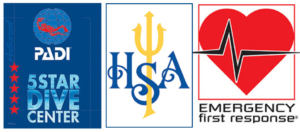WHY SCUBA DIVING WITH NITROX
The standards for diving with Nitrox were established in the 1970s by the National Oceanic and Atmospheric Administration (NOAA).
Nitrox or Enriched Air has been available in recreational diving for more than twenty years. Every major scuba certification association has a Nitrox training program. Plenty of dive centres offer diving with Nitrox.
Let´s try to make it clear, answering to 3 basic questions:
What exactly is Nitrox?
Nitrox = nitrogen/oxygen.
The air in the scuba tank and the one that we breathe on the surface is a mix of 21% oxygen and 79% nitrogen. In other words, Nitrox 21.
The most common Nitrox mix is 32 and 36, that is:
32% oxygen and 68% of nitrogen
36% oxygen and 64% of nitrogen respectively.
The recreational Nitrox may contain anything between 21% and 40% of oxygen.
What are the benefits over regular air?
-As we all know, when we dive and breath, the compressed air, the water pressure causes nitrogen to dissolve in our bloodstream.
The deeper or the more a diver dives in a day, the more nitrogen will dissolve. After a certain time, the concentration of nitrogen builds up and it is necessary to go back to the surface slowly in order to avoid decompression stops or a case of decompression sickness.
+Diving with lower nitrogen concentration in Nitrox can extend dive time as will help us absorbing less nitrogen.
For example:
Using air and diving to18m, we will have a maximum time of 60 minutes
Using EAN32 and diving to 18m, will be able to stay 92 minutes, and with EAN36 up to 125 minute.
+Shorter Surface Intervals for divers who are eager to get back in the water. A diver using Nitrox absorbs less nitrogen on a dive than one who uses air. Which means that the diver have less nitrogen to off-gas during a required surface interval.
+As we know the lower nitrogen absorption extend divers no-decompression dive time. This means that Nitrox divers will have a longer allowable bottom time on a repetitive dive.
+ Divers claim to be less tired after dives using Nitrox. That is caused by the lower absorption of nitrogen in the body.
+Less nitrogen in your body decrease the chance of decompression sickness improving this way your safety.
What are the risks you should be aware of while diving with Nitrox?
-Oxygen Toxicity and Depth Limits.
One of the main risk is oxygen toxicity. A diver using air, would have to dive over 60 meters deep to experience oxygen toxicity. The risk of Nitrox is that it brings this possibility within recreational diving depths because of higher concentration of oxygen in the given mix.
Two factors that Nitrox divers must take into consideration to avoid oxygen toxicity:
The amount of oxygen and the length of the dive.
For the recreational scuba community is recommended a maximum oxygen partial pressure of 1.4 ATA. For example, the maximum depth for EAN32 is 34 meters and EAN36 is 28 meters.
-Tanks with enriched air are usually clearly marked with a tank band or a sticker, stating the mix percentage.
Are you wandering how to get your license? It’s much easier than you may think!
At Black Frog Divers, we provide two kind of Nitrox course:
Dry course: 100€ + Learning material
You will first studying comfortably at home, thanks to the PADI eLearning material. Once finished the theory, the course takes place in our classroom. The instructor will explain few more things about Nitrox, will go through doubts and problems and will show how to analyze the gas in the tanks thanks to the 02 Analyser
Wet course: 200€ + Learning material.
The course comprise the same theory plus two dives with Nitrox to actually experience it.
You need to be at least 12 years old and PADI Open Water Diver certified.
Ready to take your Nitrox Speciality??!!! Contact us for more info.










